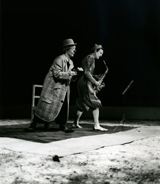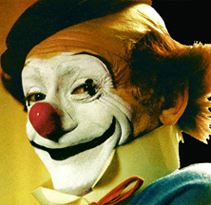by Pascal Jacob
A magician left us on 14 October 2016 – Pierre Etaix: a clown, illustrator, filmmaker, playwright and poet all in one. He nourished each of these disciplines with the inexhaustible richness of his multiple talents, creating incessantly, tirelessly dreaming up projects for books, shows and posters, covering countless sheets of paper with ideas and drawings – fragile yet powerful illustrations of his overflowing imagination.
Born in Roanne in 1928, he developed a close relationship with Jacques Tati, and was his assistant for Mon Oncle. He soon turned to slapstick and its singular culture, swiftly appropriating a vibrant, joyous, spectacular vein. Inspired by Buster Keaton, he invented his own precise and elegant style, creating an airy silhouette; a subtle character with a white mask balanced by pure calligraphic lines drawn in the blackest of inks and anchored by a traditional red nose.
Pierre Etaix made a choice: not to make any choices, like the remarkable dilettantes of the Florentine Renaissance whose versatility was their greatest source of creativity. Unable to bring themselves to focus on one specific artistic form of self-expression, they excelled in everything.
His meeting with Jean-Claude Carrière had an influence on his work in the cinema. Together they wrote and directed short comic films, one of which, Heureux Anniversaire (Happy Anniversary), won an Oscar in 1962. They also wrote plays and other films, including the moving Yoyo, a light-hearted, imaginative parable on the crucial need to give laughter and artists a decisive place in our societies.
And then Pierre Etaix met Annie Fratellini. Captivated, he cast her in Le Grand Amour (The Great Love) in 1969. As a passionate circus lover, he helped her to rediscover a world to which she had once belonged but had somewhat forgotten. Together, they founded the École Nationale de Cirque (National Circus School) in 1974: a truly precious gift for future generations, and a magnificent and generous idea. But he was also the "sad" clown to her "happy" clown, and they made an unforgettable duo for all those lucky enough to see them in the ring, where they mingled the splendidly classical with dazzling contemporary touches.
The tenderest and most touching image in Yoyo is undoubtedly the scene of the circus caravans disappearing into a misty dawn, leaving behind only the memory of past enchantments.
Pierre Etaix is gone, but his entire output is still here, helping us to see the world differently and to love it, vibrant as it is with extraordinary, mysterious colours. The kind of colours – dense, translucent, light or dark – that could only be dreamed up by a true magician.






